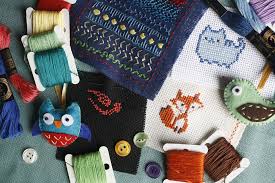Learn When to Use Cotton, Linen, Paper, Plastic Canvas, Waste Canvas
Cross-stitchers can choose from a wide variety of different fabrics, each with its own advantages and disadvantages. Here’s a beginner’s guide to the available options.
Counted cross-stitchers use special fabrics that are woven specifically to make counting stitches easier. These fabrics are also known as evenweave fabrics because they have the same number of threads per inch from top to bottom as they do from left to right. Some threads may be thicker than others, especially in linen fabrics, but the thread count of an evenweave fabric will always be the same vertically and horizontally.
Fabric Count Measures Threads per Inch
Every cross stitch fabric has a “count” that identifies the number of threads or squares per linear inch. A fabric marked 12-count, 12ct, or 12 HPI, has 12 threads or squares per inch. Some linen fabrics have more than 30 threads per inch. The higher the fabric count, the smaller your stitches will be.
Aida Fabric, a Good Choice for Beginning Cross Stitchers
Aida fabric is 100% cotton, evenweave fabric woven with groups of threads bunched together to leave well-defined square holes between the threads. Some of Aida’s advantages:
- Aida fabrics come in a large assortment of colors and thread counts.
- The visible grid of squares makes it easy to keep track of stitches and find the correct place to put the needle.
- The grid on Aida fabrics matches the grid on counted cross-stitch patterns, making it easy to follow the pattern.
- Aida is rather stiff, which means it can be stitched without a hoop.
One disadvantage of Aida fabric is that the background of the design shows the woven squares. The grouped threads can also make fractional stitches more difficult.
Other Cotton Evenweave Fabrics—Davosa, Hardanger, Jobelan, Linda
There are many, many evenweave fabrics to choose from. Each one has a different weave, fiber content, and finish. Here are a few you may want to try:
- Davosa fabric. This is a 100% cotton, 18-count (18 threads to the inch) evenweave fabric that looks less bulky than Aida.
- Hardanger fabric. This 22-count (22 threads to the inch) cotton block weave fabric was designed for Norwegian Hardanger embroidery, but it can also be used for counted cross stitch. The threads are arranged in pairs. The holes in Hardanger are smaller than the holes in Aida fabric.
- Jobelan fabric. A soft, cotton/rayon blend evenweave fabric designed for stitching linens, pillows, and apparel. It hangs and washes well, and is less expensive than most linens.
- Linda fabric. A tightly woven 100% cotton fabric manufactured by Zweigart. It produces a better-looking background than Aida fabric.
There are too many different evenweave fabrics to list them all here. A visit to a store that offers cross stitch supplies is a good idea for anyone just getting started with counted cross stitch.
Linen Cross Stitch Fabrics, the Traditional Favorite
Beautiful and expensive, linen has been used for cross stitch embroidery for hundreds of years. Linen has a stiff feel and makes a magnificent background to show off your stitching. It is also more challenging to work with than Aida fabric for several reasons:
- High thread counts (up to 30+) mean that smaller stitches are required to work with linen.
- Irregularities called slubs make linen harder to work with than perfectly even fabrics.
- It is harder to control thread tension and create even stitches.
Make sure the linen you choose is woven tightly enough that threads won’t show through from the back. Any cross stitch store will carry a variety of different linens.
Perforated Paper and Plastic Canvas for Stiff or 3-D Projects
Cross-stitching an item that is stiff or three-dimensional, such as tissue boxes, bookmarks, samplers, ornaments, or pins, requires a stiffer base “fabric.” Two popular options are:
- Perforated paper, which first became popular in the Victorian era as a less-expensive alternative to linen. Perforated paper has a grid pattern of holes similar to the ones in Aida fabric. It is available in some colors, usually in 14 counts (14 squares to the inch). It can be cut into shape without fraying at the edges.
- Plastic canvas is a durable plastic mesh that is used for much the same kind of projects as perforated paper but is less expensive. It is available in sheets or precut shapes in a wide variety of counts. Plastic canvas is easy to cut, won’t ravel, tear, or shrink, and is stiff enough to use for 3-D projects.
Waste Canvas to Cross Stitch on Clothing, Tote Bags, and Quilts
Waste canvas is a fabric grid that makes it possible to cross stitch on fabrics that don’t have an even weave, such as t-shirts, jeans, quilts, or tote bags. It is called “waste” canvas because it is temporary and gets removed after stitching. The threads in the waste canvas are held together by a water-soluble glue. After stitching, the glue is washed away, and the fibers pulled out, leaving the cross stitching attached to the fabric underneath.
Waste canvas is available in some different fabric counts. The threads are marked with a grid to help you with counting stitches.
Experiment to Find Your Favorite Cross Stitch Fabrics
As with any craft, it takes time and experimentation to discover your own favorite supplies, tools, and ways of working. If one type of fabric doesn’t appeal to you, there are many other possibilities available.

